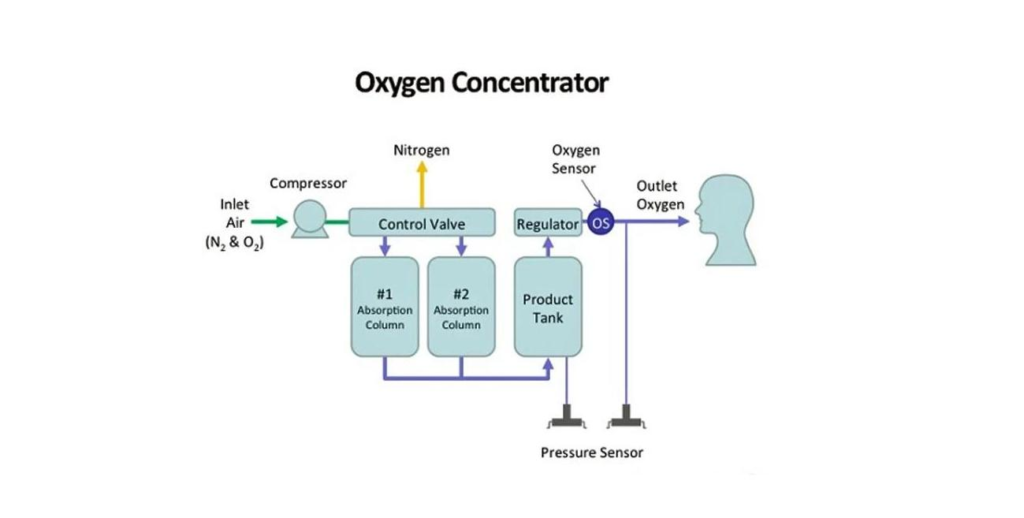Since the outbreak of the epidemic, the oxygen concentrator in various countries market popularization, and it has become an important tool to save tens of thousands of lives.
An oxygen concentrator is a medical device that provides long-term oxygen therapy to people who can not breathe on their own. Unlike oxygen cylinders that store compressed gas or liquid oxygen, oxygen concentrators use the surrounding air to make and supply oxygen more economically and efficiently. ( Differences between oxygen concentrators and compressed gas cylinders.)
How does the oxygen concentrator work?
First, the device sucks in ambient air (mainly nitrogen and oxygen) through a compressor. The air is then filtered through several filters that remove nitrogen and purify oxygen. Pure oxygen is then delivered through a pressure regulator (which controls the flow of air) and is then delivered to the patient through an oxygen tube and a mask or nasal catheter.
Based on its popularity and clear use, oxygen concentrators are numerous and have different characteristics and benefits. With this in mind, finding the right product to meet your needs or those of your loved ones may seem like a challenge. With this in mind, this article provides some information you need to know and helps you determine which oxygen concentrator is best for you by listing some of the most important features and benefits to consider. ( The best oxygen concentrator of 2022 )
Why Oxygen Concentrator Is Needed in our working and home life?
Oxygen concentrators have been shown to play an important role in COVID-19. Covid-19 is a respiratory disease that spreads through your airways and into your lungs. When this happens, the cell walls become thicker, causing edema and reducing oxygen diffusion. This is the importance of high-flow oxygen therapy through an oxygen concentrator.
The oxygen concentrators weren’t just for Covid-19, they were already used to treat all sorts of diseases around the 1970’s, such as asthma, COPD, pulmonary edema, heart failure, sleep apnea, pneumonia, cystic fibrosis, chronic hypoxemia and so on.
- People with moderate disease are 90% to 94% more likely to have any of these oxygen saturation.
- Severe cases, where Oxygenation is below 85%, can also be treated with oxygen concentrators before they arrive at the hospital.
- Compressed oxygen or liquid oxygen can also be used when it is too inconvenient or dangerous. These include family, mobile clinic, or emergency situations.
How to choose oxygen concentrator?
- Oxygen flow rate
- Portablility or Stationary
- Oxygen purity
- Noise level
- Power consumption
Oxygen flow rate
One of the most important factors to consider when buying an oxygen concentrator is the oxygen flow rate. Flow rate is the rate at which oxygen is transported from the machine to the patient, usually expressed in “L/min”. It is recommended to have full communication with your doctor before purchasing an oxygen generator.
The flow rate of common oxygen concentrator is 1L, 3L, 5L, 8l, 10L/min. Ensure that the purchased equipment has an adjustable flow meter. This helps to adjust the flow rate of the oxygen concentrator to the specific needs of the user. For example, a stable patient who requires static levels of oxygen may choose a device with a relatively low output. However, patients with severe respiratory distress or hospitalization require higher output of the device. It is suggested that the oxygen concentrator with greater demand than the actual oxygen flow should be chosen in case of emergency.
Portablility or Stationar
When considering the oxygen concentrator, the first and most important thing to consider is how mobile the oxygen concentrator is. Oxygen concentrators vary greatly in size and portability.
Portable oxygen concentrators, usually weighing 2-5kgs, have a low flow rate and are suitable for carrying and transportation.
The weight of the domestic oxygen generator is 14-24kgs, the larger the flow rate, the larger the volume and weight, can choose the suitable oxygen concentrator according to their own needs.
Oxygen purity
Compressed and filtered oxygen concentrators deliver oxygen to the patient at a specific percentage of pure oxygen content. This value is called oxygen concentration. The level of oxygen concentration depends on the number and design of filtration systems in the oxygen concentrator and the effectiveness of the denitrogenation screen system
in the concentrator.
Although most products provide an oxygen concentration value between 87% and 96% , it is important to note that this value may vary from one concentrator to another. In general, higher power products designed for patients who require a higher oxygen flow also provide higher oxygen concentrations, portable oxygen concentrators designed for active patients usually do not require the highest concentration of oxygen.
Normally, oxygen concentration below 80% , oxygen concentrator will alarm.
Noise level
The oxygen concentrator will produce noise in the process of operation, the noise problem is easy to be ignored. Due to the diversity of the configuration, layout and power level of the oxygen concentrators, the noise levels generated during operation may vary. The noise of portable
oxygen concentrator is small, the flow rate of home oxygen concentrator is large, the flow rate of oxygen concentrator needs higher power source, so usually, the noise is larger.
Power consumption
The power the oxygen concentrator uses depends on its size and the settings you use. If you’re going to use a stationary oxygen concentrator, it won’t run on batteries.
They’re good for people who need higher levels of oxygen, so they’re bigger, they’re heavier.
Studying the ampere and Volt specs on the product’s packaging allows you to estimate how much your electricity bill might go up.
If your oxygen needs are low and stable, you can choose a battery powered concentrator. They’re lighter and easier to carry. These concentrators are equipped with battery backups so that your safety is not compromised when you need them.
Frequently Questions
Do I Need a Prescription to Buy a Portable Oxygen Concentrator?
The answer is yes. This helps ensure that you get a clear analysis of your oxygen needs by a qualified medical professional, as well as an oxygen delivery device that fits your needs.
After your doctor measures your oxygen saturation and determines your oxygen needs, they will be able to prescribe supplemental oxygen therapy. Your prescription will indicate your oxygen level and other health information relevant to your particular situation, which will help you get the oxygen delivery device that suits your needs.
Can I sleep while using an oxygen concentrator?
In most cases, sleeping next to a portable oxygen concentrator is perfectly fine, but you should talk to your doctor regularly, depending on your recovery.
How long the working life of most oxygen concentrators last?
Depending on the concentrator and how it is used on a daily basis, an oxygen generating device can normally be used for five to seven years. Regular maintenance of the oxygen generator will extend its service life. (How do you maintain a home oxygen concentrator?)
What are effects of using an oxygen concentrator?
Oxygen therapy is usually safe, but it can also cause side effects. They include a dry or bloody nose, fatigue and morning headaches. Oxygen is a fire hazard, so you should not smoke or use flammable materials when using oxygen.
Conclusion
While these are the most important considerations, there are other factors that can help you choose the best oxygen concentrator for yourself. Some of these include warranties, ease of operation, and ease of maintenance if the brand complies with the necessary approvals to prevent some parts from wearing out. In addition to all of these factors, consider how you can use them safely to increase efficiency. They should be kept out of reach of children, should never be used near open flames, and should be cleaned regularly. ( How often should filters of the oxygen concentrator be cleaned? )
Whether you use a portable or stationary oxygen concentrator, you can ensure that you get the best supply of oxygen each time you need it, with these expert tips.




